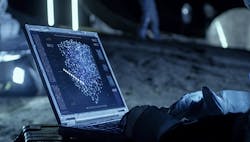Data analysis can offer many insights that manufacturers can use to reduce equipment downtime or increase productivity. Collecting the data is the first step. Machine builders and system integrators have been including sensors on equipment for decades.
Once the data is collected, it needs to be sent somewhere to be analyzed. Edge computing offers the opportunity use the data where it’s needed, without transmitting it elsewhere. But cloud computing allows companies to aggregate data from a variety of sources and run algorithms based on more information. Which is best?
Also read: Where IT and OT converge
What if I told you there was another option beyond the cloud?
The International Space Station National Laboratory (ISSNL) recently began running its second Hewlett Packard Enterprise (HPE) supercomputer, the Spaceborne Computer 2 (SBC-2) in orbit around Earth.
The data being analyzed is from research being conducted on the space station. “The point of that is you don't have to send it down to Earth to be analyzed, which is not easy to do and wastes time,” explains Christine Kretz, vice president of programs and partnerships at the ISSNL. “The purpose is to create faster data analytics at the source, whatever the data. Currently, the information is largely genomic studies data, which is a fairly large data set.”
The results of the analysis, rather than the whole data set, can be sent to the researcher on Earth. Think of it as edge computing at the edge of space.
“There are a lot of projects that are testing opportunities for manufacturing in space, including regenerative medicine and biomanufacturing efforts and some exotic glass and fiber testing,” adds Kretz.
The opportunities are as limitless as, well, as limitless as space itself.
Imagine the advantages, as space travel and exploration become more commonplace, to use onboard supercomputers to analyze data, without needing to transmit it back to Earth first, no matter how reliable or secure the network may be.
Manufacturing in space and computing in space are now proven use cases. Since 2014, components 3D-printed on the ISS have become increasingly complex. And, with the ability to analyze data, enabled by the HPE SBC-2, not to mention the next generations of computers in space, the edge, the cloud and space could become interchangeable.
“With as many trips as rockets are making, it’s not going to be too far into the future that you can make products in space and bring them back to install,” predicts Kretz.
Mike Bacidore is the editor in chief for Control Design magazine. He is an award-winning columnist, earning a Gold Regional Award and a Silver National Award from the American Society of Business Publication Editors. Email him at [email protected].
About the Author
Mike Bacidore
Editor in Chief
Mike Bacidore is chief editor of Control Design and has been an integral part of the Endeavor Business Media editorial team since 2007. Previously, he was editorial director at Hughes Communications and a portfolio manager of the human resources and labor law areas at Wolters Kluwer. Bacidore holds a BA from the University of Illinois and an MBA from Lake Forest Graduate School of Management. He is an award-winning columnist, earning multiple regional and national awards from the American Society of Business Publication Editors. He may be reached at [email protected]

Leaders relevant to this article:


